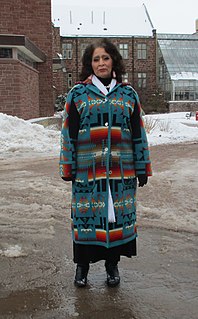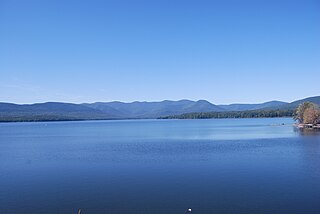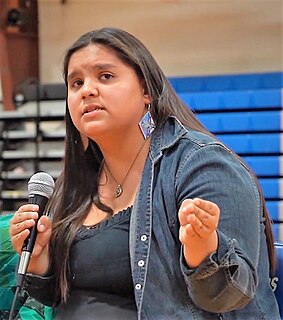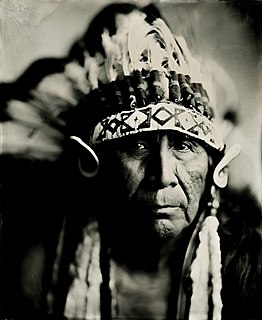
Morton County is a county in the U.S. state of North Dakota. As of the 2020 census, the population was 33,291, making it the seventh-most populous county in North Dakota. Its county seat is Mandan. Morton County is included in the Bismarck, ND, Metropolitan Statistical Area.

The Standing Rock Reservation lies across the border between North and South Dakota in the United States, and is inhabited by ethnic "Hunkpapa and Sihasapa bands of Lakota Oyate and the Ihunktuwona and Pabaksa bands of the Dakota Oyate," as well as the Hunkpatina Dakota. The Ihanktonwana Dakota are the Upper Yanktonai, part of the collective of Wiciyena. The sixth-largest Native American reservation in land area in the US, Standing Rock includes all of Sioux County, North Dakota, and all of Corson County, South Dakota, plus slivers of northern Dewey and Ziebach counties in South Dakota, along their northern county lines at Highway 20.
Energy Transfer LP is a company engaged in natural gas and propane pipeline transport. It is organized under Delaware state laws and headquartered in Dallas, Texas. It was founded in 1995 by Ray Davis and Kelcy Warren, who remains Chairman and CEO. It owns a 36.4% interest in Dakota Access, LLC, the company responsible for developing the controversial Dakota Access Pipeline.
In the early 1960s, an interest in women and their connection with the environment was sparked, largely by a book written by Esther Boserup entitled Woman's Role in Economic Development. Starting in the 1980s, policy makers and governments became more mindful of the connection between the environment and gender issues. Changes began to be made regarding natural resource and environmental management with the specific role of women in mind. According to the World Bank in 1991, "Women play an essential role in the management of natural resources, including soil, water, forests and energy...and often have a profound traditional and contemporary knowledge of the natural world around them". Whereas women were previously neglected or ignored, there was increasing attention paid to the impact of women on the natural environment and, in return, the effects the environment has on the health and well-being of women. The gender-environment relations have valuable ramifications in regard to the understanding of nature between men and women, the management and distribution of resources and responsibilities, and the day-to-day life and well-being of people.
The Indigenous Environmental Network (IEN) is a coalition of indigenous, grassroots environmental justice activists, primarily based in the United States. Group members have represented Native American concerns at international events such as the United Nations Climate Change conferences in Copenhagen (2009) and Paris (2016). IEN organizes an annual conference to discuss proposed goals and projects for the coming year; each year the conference is held in a different indigenous nation. The network emphasizes environmental protection as a form of spiritual activism. IEN received attention in the news as a major organizer of the fight against the Keystone Pipeline and the Dakota Access Pipeline in the Dakota Access Pipeline protests.

The Dakota Access Pipeline (DAPL) or Bakken pipeline is a 1,172-mile-long (1,886 km) underground oil pipeline in the United States. It begins in the shale oil fields of the Bakken Formation in northwest North Dakota and continues through South Dakota and Iowa to an oil terminal near Patoka, Illinois. Together with the Energy Transfer Crude Oil Pipeline from Patoka to Nederland, Texas, it forms the Bakken system.

The Dakota Access Pipeline Protests, also called by the hashtag #NoDAPL, began in early 2016 as a grassroots opposition to the construction of Energy Transfer Partners' Dakota Access Pipeline in the northern United States. The pipeline runs from the Bakken oil fields in western North Dakota to southern Illinois, crossing beneath the Missouri and Mississippi rivers, as well as under part of Lake Oahe near the Standing Rock Indian Reservation. Many members of the Standing Rock tribe and surrounding communities consider the pipeline to be a serious threat to the region's water. The construction also directly threatens ancient burial grounds and cultural sites of historic importance.
David Archambault II is the former (2013–2017) tribal chairman of the Standing Rock Indian Reservation in North Dakota. He was instrumental in the Dakota Access Pipeline protests and continues to work to promote an understanding of the historical treaty rights and indigenous rights of Native American people. Archambault holds degrees in Business Administration and Management. In 2017 he joined FirstNation HealthCare as its chief consulting officer.

LaDonna Tamakawastewin Brave Bull Allard was a Native American Dakota and Lakota historian, genealogist, and a matriarch of the water protector movement. In April 2016, she was one of the founders of the resistance camps of the Dakota Access Pipeline protests, aimed at halting the Dakota Access Pipeline near the Standing Rock Indian Reservation in North Dakota.

Water protectors are activists, organizers, and cultural workers focused on the defense of the world's water and water systems. The water protector name, analysis and style of activism arose from Indigenous communities in North America during the Dakota Access Pipeline protests at the Standing Rock Indian Reservation, which began with an encampment on LaDonna Brave Bull Allard's land in April, 2016.

Greg Grey Cloud is a Crow Creek Nation educator, singer and activist. Grey Cloud is a co-founder of Wica Agli, a non-profit to end violence against women, children, and in general in the community. He is a notable ecologist and defender of Native American rights; gaining national attention when he sang an Honor Song in the Senate after the Keystone XL Pipeline bill was defeated, and in leading the Spirit Riders to protect the Standing Rock Reservation affected by the construction of the Dakota Access Pipeline.
Unicorn Riot is a decentralized, nonprofit, left-wing media collective that originated online in 2015. The group is known for reporting on far-right organizations and sources of racial and economic injustice in the US. The non-hierarchical media organization operates in the US cities of Boston, Denver, Minneapolis/St. Paul, and Philadelphia as well as in South Africa. They produce live streams of political rallies and protests and are funded by viewer donation and grants.
The Standing Rock Rural Water System (RWS) is a $30 million water system funded by the American Recovery and Reinvestment Act in 2009 for about 10,000 residents of the Standing Rock Sioux reservation in North Dakota. The RWS includes the Standing Rock Water Treatment and the "Indian Memorial Intake Pump Station, a raw water pipeline, two transmission pipelines and Kline Butte Storage Reservoir." The main regulation reservoir of the Standing Rock Rural Water System is the $3.6 million Kline Butte Storage Reservoir, located southwest of Kenel, South Dakota, which consists of a 5 million gallon ground storage reservoir. Currently, the intake valve for the water system is "located in a shallow part of the Missouri River near Fort Yates, North Dakota, roughly 20 miles from the planned river crossing of the controversial Dakota Access Pipeline also known as the Bakken pipeline. The Bakken oil pipeline Dakota line is to be "buried 92 feet (28 m) below the riverbed in hard clay." A new valve came online in 2016 in Mobridge, South Dakota which is seventy miles south of the proposed Bakken Pipeline Missouri River crossing. This Mobridge intake valve is intended to service the entire Standing Rock Sioux reservation.

The Pilgrim Pipeline was a planned 178-mile pipeline that would deliver up to 200,000 barrels of crude oil and other fuel products per day from Albany, New York to coastal Linden, New Jersey on the Arthur Kill.
TigerSwan is an international security and global stability firm founded in 2008 by retired U.S. Army lieutenant colonel and Delta Force operator James Reese.
The Bayou Bridge Pipeline (BBP) is a 162.5-mile crude oil pipeline from Lake Charles, Louisiana to St. James, Louisiana by Bayou Bridge, LLC, a subsidiary of Energy Transfer Partners. Communities directly impacted by the pipeline voiced health, economic, and environmental concerns. They filed a lawsuit in opposition to the project and asked the Army Corps of Engineers for an Environmental Impact Statement. The Corps refused to do so and approved the project on 15 December 2017.
A member of Standing Rock in North and South Dakota, Phyllis Young has been an American Indian rights activist (Lakota/Dakota) for more than 40 years. She is most widely known for her leadership role in the anti-Dakota Access Pipeline struggle in 2016 and 2017. Young worked for Standing Rock from October 2015 to September 2017, ultimately as an organizer of the Oceti Sakowin Camp, where tens of thousands of protesters—known as “water protectors”—gathered over time to resist construction of the 1,172 mile long oil pipeline.
Chuck Cadotte is an American powwow dancer and powwow dance-style teacher. As an enrolled member of the Dakota Standing Rock Sioux Tribe, Chuck is dedicated to supporting Indians in connecting to their cultural roots through teaching traditional Native American dances through the Soaring Eagles dance group, giving traditional blessings and participating in rallies that support Native American land rights and sovereignty.

Tokata Iron Eyes is a Native American activist and member of the Standing Rock Sioux tribe. Iron Eyes was a youth leader of "ReZpect our Water", a campaign against the proposed route of the Dakota Access Pipeline and also served on the board of a new sustainable energy group called Indigenized Energy.

Arvol Looking Horse is a Lakota Native American spiritual leader. He is the 19th keeper of the Sacred White Buffalo Calf Pipe and Bundle.











